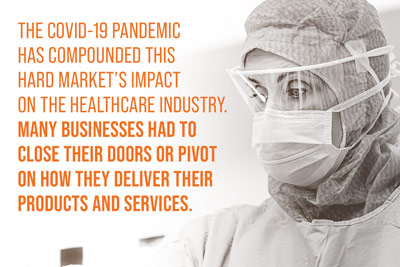
Medical Professional Insurance Faces Challenges in 2021
March 17, 2021
2020 was quite a year. The pandemic bore down on healthcare organizations, and many are still squarely in the midst of it. While COVID-19 infection rates are currently improving, healthcare organizations aren’t yet feeling the relief. At or near capacity with sick patients, with employees facing burnout from the pandemic’s continued stress, organizations are still facing a hard market for their insurance renewals. It started 12-18 months ago, and the trend isn’t abating any time soon.
Healthcare Industry Challenges
In a hard insurance market, it’s difficult to find coverage. There are fewer carriers available, fewer markets willing to offer coverage, the pricing and deductibles are expensive, and the coverage can be more restrictive. This is a contrast against the past decade’s soft market conditions where renewals were comparatively easy — many carriers were eager to write coverage, rate and premium reductions were common, deductibles were falling, and coverage could be expanded.
The COVID-19 pandemic has compounded this hard market’s impact on the healthcare industry. Many businesses had to close their doors or pivot on how they deliver their products and services. Washington non-essential healthcare businesses were closed for weeks, which had a substantial impact on revenue. While these organizations are facing suppressed revenue, their expenses — for personal protective equipment, treatments for the sickest COVID-19 patients, and insurance — are climbing.

Medical Professional Liability
While premiums are increasing on many lines of coverage, the largest impact for healthcare organizations has been medical professional insurance. Insurance companies are less focused on growth and market share and more keenly focused on profitability. They are more careful about what they will insure and more disciplined in their pricing and retentions. Everything is being carefully reviewed in this hard market. It’s easy for carriers to decline accounts, reduce their offered limits, or increase pricing. Several factors have been leading us to this point over the past few years:
- Claims. There has been a high frequency of severity in liability claims. High value verdicts are escalating at an unprecedented rate, and they are becoming more and more frequent. The collected premiums for the policies that are paying out these claims did not contemplate such large verdicts, eroding the insurers’ capital. Social inflation (i.e., erosion in the trust of corporations, the trend towards viewing plaintiffs in a sympathetic light, and an overall ambivalence to high value awards) and litigation financing have contributed to the escalating verdicts. With the backing of financiers, attorneys are willing to take on cases they would have previously passed on.
- Reinsurance. Insurers are feeling the impact of claims, as are reinsurers. Reinsurers may also write other lines of business, and two things can influence the medical professional arena:
- If reinsurers have sustained heavy losses in one area, they may increase reinsurance rates on all lines of business to recoup their losses.
- If rates increase dramatically in a non-professional area, reinsurers may redirect their capacity to coverage lines that are generating higher rates. This leaves less capacity for medical professional insurance, which can increase reinsurance rates and, in turn, increase the rates that healthcare providers pay.
- Consolidation. Since the passing of the Affordable Care Act in 2010, there has been increasing consolidation in the healthcare space. This leaves fewer policyholders and an overall lower premium volume in the marketplace. While the risks are the same, claims costs are climbing, and the carriers have fewer premium dollars to cover the eventual losses.
Looking Forward to 2021
These factors have been coalescing over the past few years to create a challenging insurance marketplace. In 2021, we will also face the following:
- COVID-19 claims. COVID-19 had the most prevalent impact on property insurers and workers’ compensation carriers. Carriers, especially those that write property insurance or seek reinsurance for property insurance, are facing a high volume of COVID-19 claims. While a few carriers and reinsurers provided coverage for such an event, almost all incurred costs to evaluate the submitted claims, which will factor into 2021 renewals. Although numerous policyholders have submitted notices of circumstances, the impact of claims and litigation will take years to play out.
- Endemic risk. Perpetually, medical professional insurers grapple with exposures that are endemic to the industry, such as abuse and molestation, and opioids. These are carefully underwritten, and insurers struggle with how to price for these risks, how broad their coverage should be, and how much limit to offer. As the market continues to harden, we may face even more scrutiny in underwriting and coverage or see carriers exclude these coverages altogether.
As you head into your 2021 insurance renewal, there are some steps that you can take to mitigate the hard market’s impact:
- Start early. Every broker is talking to every insurance company about every risk. Ensure that you and your broker have enough time to discuss your company with all of the markets thoroughly.
- Provide more detail. Be prepared to provide more information than you have in the past about your company, operations, safety protocols, and insurance program.
- Prioritize. Spend some time evaluating your insurance program to determine what features are the most important to you. If it’s premium, are you willing to take a higher deductible to keep your premium low? If it’s limits, are you ready to pay a higher premium to maintain those limits? Be clear on your priorities as you may face some tough trade-offs this year.
- Resources. Explore the resources that your broker and insurer can provide. Some of them are available for little or no cost, which can help offset some of the premium increases.
- Education. Take advantage of the educational resources available from your insurer if they offer them. Not only can it save costs, but some carriers offer a premium credit to customers that complete the courses. Ask if your carrier offers credit, and be sure to understand which classes apply to any credits before jumping in.
As you begin to plan for your 2021 insurance renewal, be sure that you are working with a broker specializing in medical professional liability. In a soft market, most brokers could deliver good results. However, if you want the best possible results in 2021, you should be working with a broker that knows your industry and has the market relationships to negotiate the best outcome for your organization.
The views and opinions expressed within are those of the author(s) and do not necessarily reflect the official policy or position of Parker, Smith & Feek. While every effort has been taken in compiling this information to ensure that its contents are totally accurate, neither the publisher nor the author can accept liability for any inaccuracies or changed circumstances of any information herein or for the consequences of any reliance placed upon it.




